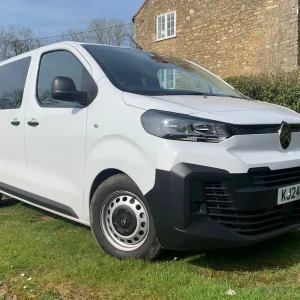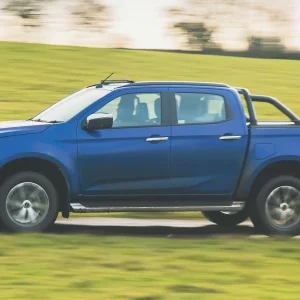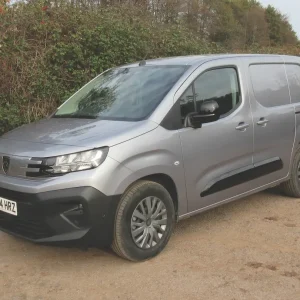It’s hard to overstate the impact the Ford Transit Custom has had on the UK’s light commercial vehicle sector since its launch in late 2012.
It rapidly established itself as the nation’s best-selling van ahead of its big brother, the Transit. Ford has totted up sales of 206,000 in under six years and claims that if the Transit brand as a whole was an original vehicle manufacturer (OVM) in its own right, it would be the eighth most popular manufacturer in the UK – including passenger cars as well as LCVs.
Iain Brooks, CV product marketing manager for Ford of Britain, points out the Custom was the sixth best-selling vehicle overall in the UK last year.
Ominously for all the other brands in the marketplace trying to hang onto Ford’s coat tails, the manufacturer is confident, as fleet director Owen Gregory puts it, that “the new product will build upon the success of the current one”.
The facelifted Transit Custom went on sale just ahead of the CV Show where it took a prominent place on Ford’s stand.
Engine and gearbox
The engine line-up is based on the 2.0-litre Ecoblue introduced in 2016 with outputs of 105hp, 130hp and 170hp, but new to the range when it comes on board in the summer will be the Econetic (based on the 105hp unit), which delivers an official 49.6mpg with CO2 of 148g/km – a 6% improvement over the most efficient current van. Available in short-wheelbase form only the Econetic features a unique engine calibration, auto stop-start, low rolling-resistance tyres,
Ford’s Acceleration Control device and a fixed 62mph speed limiter.
Trim levels for the Transit Custom range are Base, Trend, Limited and Sport Van, with prices, excluding VAT, going from £20,995 to £32,000.
Driving
Chris Hamilton, chief designer for Ford of Europe, explains the brand has given the updated Custom a new front end with a three-bar upper grille that ties in with the design of the Fiesta and Focus cars. The passenger-carrying Tourneo gets a five-bar grille that Hamilton says is not so hard-wearing.
He says durability has also been enhanced by the addition of a protective, removable panel to guard against scrapes to the underside after Ford discovered the original Transit Custom would occasionally ‘ground’ when traversing speed humps and ramps. Hamilton also draws attention to a new more aerodynamic fender design, but it is to the interior that Ford has made the biggest changes with the introduction of more storage space and technology carried over from the car range.
The results are class-leading and, indeed, authentically car-like.
As Hamilton says : “It’s not [just] a van with seats.”
It’s out on the road that the Sport Van comes into its own – although it has to be said there are no slouches in the Custom range.
The driving position is as good as it gets in an LCV, rake and reach steering adjustment is included on all Custom variants, and the short gear stick is within easy reach of the driver. The gear change is snappy and precise and offers a more dynamic drive than the six-speed auto, which we sampled on a 130hp Limited van. The steering wheel is small but pleasingly chunky to hold while the steering itself is nicely weighted and directs the van exactly where you want.
It almost goes without saying that the 170hp engine is as keen as mustard and delivers the sort of performance more readily associated with hot-hatch passenger cars, and a payload of more than 800kg and a 6.0m3 load space are testament to the L1H1 Sport Van’s practicality too.


Interior and equipment
Hamilton explains more emphasis has been put on width with the dashboard layout, rather than having everything concentrated in the centre, as with the previous model, which did come in for some criticism for having fiddly buttons and a lack of practical places to put things.
Ford claims the instrument panel alone now offers 25 litres of storage, including three open bins on its upper surface with space for clipboards or mobile devices, and glovebox stowage capable of storing A4 files in the lower closed compartment.
A fold-out cup holder beneath the gear lever has been added to the cup holders and two-litre bottle holders at each end of the instrument panel. The door panels now house three stowage spaces, and a new grab handle has been integrated into the door trim.
Ford says this user-centric interior layout was influenced by consumer use of smart devices and tablets.
Flagship models get a floating, tablet-inspired eight-inch colour touchscreen with Ford’s Sync 3 communications and entertainment system that can be operated with pinch and swipe gestures.
For vans not equipped with eight-inch or four-inch displays, the MyFord Dock in the centre of the instrument panel provides a location for drivers to mount and charge smartphones, MP3 players or satellite navigation systems. USB and 12V power sockets are found in the upper stowage bin in front of the driver, and alongside the gear lever to enable device charging.
The facelifted model is the first LCV in the brand’s line-up to get Ford’s Intelligent Speed Limiter, which allows automatic adjustment of maximum speed to remain within legal limits via the Traffic Sign Recognition system. Other new safety kit includes Blind Spot Information System with Cross Traffic Alert, which warns drivers reversing out of a parking space of vehicles about to cross behind them.
We tested the top-of-the-range Sport Van, which comes exclusively with the 170hp powertrain, in short-wheelbase/low-roof mode (L1H1) and with six-speed manual transmission. This model gets the eight-inch colour touchscreen with Sync 3, DAB, and Emergency Assistance that in fact becomes the focal point of the dashboard on the Limited trim level beneath Sport.
Drop down to Trend and you have to make do with the 4.2in screen, which is the specification where cruise control with adjustable speed limiter come on board too. In a line-up that is generally well-specified from the entry-level point, it is surprising that air-conditioning is only included on Limited and Sport derivatives, as are heated front seats.
Much of what you get with Sport that’s not included in the Limited mix is cosmetic and designed for operators – such as small business owners – who want to promote their brand and stand out from the crowd.
Such features include leather seat trimming, 18in as opposed to 16in alloys, exterior stripes, the Sport styling kit with front, lower bumper skirt, body-colour side skirts, rear bumper skirts, and front and rear wheel-arch extensions.
Of more practical use are the tyre pressure monitoring system, lane-keeping alert with driver alert and the excellent rear-view camera with trailer hitch assist. The front and rear parking sensors are added on Trend models.
Transit Custom Sport 290 170hp L1H1
Price (ex VAT) £30,900
Price range (ex VAT) £20,995-£32,000
Insurance group 33E
Warranty 3yrs/100,000mls
Service intervals 36,000mls
Load length 2,555mm
Load width (min/max) 1,390/1,775mm
Load bay height 1,406mm
Gross payload 808kg
Load volume 6.0m3
Engine size/power 1,996cc/170hp
Combined fuel economy 44.1mpg
CO2 165g/km






